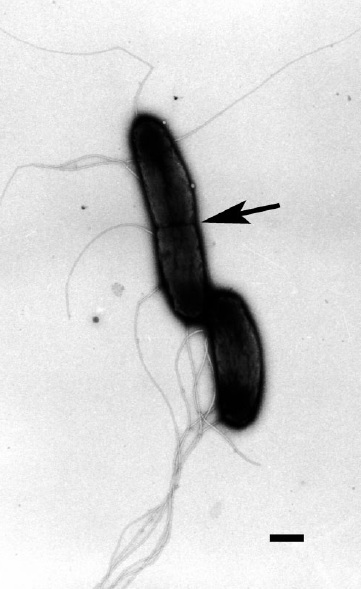Sulfurihydrogenibium azorense Az-Fu1
Click on image to enlarge
-
Domain: Bacteria
-
Phylum: Aquificae
-
Class: Aquificae
-
Order: Aquificales
-
Family: Hydrogenothermaceae
-
Genera: Sulfurihydrogenibium
-
Specie: S. azorense Az-Fu1
Sulfurihydrogenibium azorense (вид Az-Fu1 / DSM 15241 / OCM 825) это окисляющие водород, термофильные, хемолитоавтотрофные, микроаэрофильные (хорошо растущие в присутствии небольшого количества свободного кислорода) грамотрицательные бактерии полученные из наземных горячих источников в Фурнаше на острове Сан-Мигель (входит в состав архпелага Азорских островов),Португалия. Этот вид является первым наземным представителем порядка Aquificales.
Sulfurihydrogenibium azorense (strain Az-Fu1 / DSM 15241 / OCM 825) is an hydrogen-oxidizing, thermophilic, strictly chemolithoautotrophic, microaerophilic Gram-negative bacterium isolated from terrestrial hot springs at Furnas, Sao Miguel Island, Azores, Portugal. It is the first terrestrial representative of the Aquificales.
Description:
Sulfurihydrogenibium azorense (a.zo.ren9se. N. L. neut. adj. azorense from the Azores, the place of isolation).Motile rods, 0,4–0,5 x 0,9–2,0 mm. Cells can occur singly,in pairs or in filamentous clumps. Colonies are translucent. Grows best in the presence of sulfur compounds. Optimal growth occurs at 68 C and growth occurs from 55 to 73 C. The optimal pH for growth is 6,0, with a rangefrom 5,5 to 7,0. Grows fastest with 0,1% (w/v) NaCl; growth is inhibited with NaCl concentrations above 0,25 %. Not capable of growth at 12% (v/v) O2 final concentration. Doubling time of 2,5 h with O2 as electron acceptor and H2 as electron donor. Cells utilize H2, thiosulfate, Su or Fe2+ as electron donors and O2, Su and Fe3+ as electron acceptors, but cannot use nitrate as electron acceptor. The G+C content is 33,6 mol%. Isolated from a terrestrial hot spring (68,4C, pH 5,9) in the A gua do Caldeira˜o area,Furnas, on Sa˜o Miguel Island, Azores. The type strain is Az-Fu1T (=DSM 15241T=OCM 825T). The GenBank accession number for the 16S rRNA sequence of Az-Fu1T is AF528192.
Comparison with related genera and species
Together with Sulfurihydrogenibium subterraneum, Az-Fu1T forms a distinct bacterial lineage within the Aquificales, with a similar low G+C content. Both strains share many characteristics with the rest of the Aquificales, such as microaerophilic growth. However, their distinct ability to use heavy metals and iron compounds as electron donors or acceptors distinguish them from other members of the Aquificales. There are several distinguishing features that set Az-Fu1T apart from Sulfurihydrogenibium subterraneum, such as salt tolerance and pH growth optima. These differences may reflect their different habitats; Az-Fu1T has been obtained from terrestrial hot springs whereas Sulfurihydrogenibium subterraneum was obtained from a warm subterranean gold mine. Furthermore, unlike Sulfurihydrogenibium subterraneum, Az-Fu1T cannot grow aerobically, nor can it use nitrate as an electron acceptor. With the exception of Hydrogenothermus marinus and ‘Aquifex aeolicus’ , all marine Aquificales isolates described to date are able to grow with O2 and NO3- as electron acceptors and H2 as an electron donor, suggesting that perhaps Sulfurihydrogenibium subterraneum is more marine in origin. Furthermore, based on a conservative estimate and comparing only homologous nucleotides, Az-Fu1T is 2% different from Sulfurihydrogenibium subterraneum in the 16S rRNA sequence. Based on the phylogenetic position and distinct physiological characteristics of Az-Fu1T, researchers propose that this isolate be named Sulfurihydrogenibium azorense and that's why her genome was sequenced.
Component name Protein count Type Length (bp) Av. CDS Length GC content CDS coverage Gene count Chromosome 1725 
1640877 900.903 32.8% 95% 1725 1708
Genome(s) sequenced
Chromosome EMBL accession number CP001229 (circular; 1,640,877 bp) (download entry) (download Genome Reviews).
[1] PubMed=19136599; [ NCBI , EBI , Israel , Japan ]
Reysenbach A.-L., Hamamura N., Podar M., Griffiths E., Ferreira S., Hochstein R.,Heidelberg J., Johnson J., Mead D., Pohorille A., Sarmiento M., Schweighofer K.,Seshadri R., Voytek M.A. ;
"Complete and draft genome sequences of six members of the Aquificales.";
J. Bacteriol. 191:1992-1993(2009).


